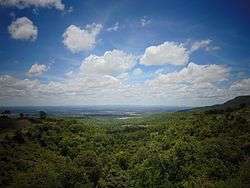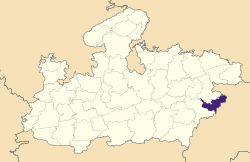Anuppur district
Anuppur District (अनूपपुर) is an administrative district in Shahdol Division of Madhya Pradesh state in central India.
Anuppur district | |
|---|---|
District of Madhya Pradesh | |
 | |
 Location of Anuppur district in Madhya Pradesh | |
| Country | India |
| State | Madhya Pradesh |
| Division | Shahdol |
| Headquarters | Anuppur |
| Government | |
| • Lok Sabha constituencies | Shahdol |
| Area | |
| • Total | 3,701 km2 (1,429 sq mi) |
| Population (2011) | |
| • Total | 749,237 |
| • Density | 200/km2 (520/sq mi) |
| Demographics | |
| • Literacy | 69.08 per cent |
| • Sex ratio | 975 |
| Time zone | UTC+05:30 (IST) |
| Website | http://anuppur.nic.in |
The district has an area of 3701 km², and a population of 749,237 (2011 Census). 309,624 people are from scheduled tribes and 48,376 are scheduled castes. The district is bordered by Koriya District of Chhattisgarh state on the east, Bilaspur District of Chhattisgarh on the southeast, Dindori District of Madhya Pradesh on the southwest, Umaria District of Madhya Pradesh on the west, and Shahdol District on the northwest and north. The administrative headquarters of the district is Anuppur.
The district has one Jawahar Navodaya Vidyalaya, and Indira Gandhi National Tribal University, a central university at Amarkantak.
The district was created on 15 August 2003 out of Shahdol District. It is part of Shahdol Division.
Anuppur district is mostly hilly and forested. The Narmada River originates from the hill of Amarkantak in the Maikal Hills, and the Son River originates nearby.
Demographics
| Year | Pop. | ±% p.a. |
|---|---|---|
| 1901 | 128,297 | — |
| 1911 | 146,726 | +1.35% |
| 1921 | 136,290 | −0.74% |
| 1931 | 164,224 | +1.88% |
| 1941 | 187,591 | +1.34% |
| 1951 | 205,240 | +0.90% |
| 1961 | 249,115 | +1.96% |
| 1971 | 310,763 | +2.24% |
| 1981 | 418,833 | +3.03% |
| 1991 | 556,074 | +2.87% |
| 2001 | 667,155 | +1.84% |
| 2011 | 749,237 | +1.17% |
| source:[1] | ||
According to the 2011 census, Anuppur district has a population of 749,237,[2] roughly equal to the nation of Guyana[3] or the US state of Alaska.[4] This gives it a ranking of 492nd in India (out of a total of 640).[2] The district has a population density of 200 inhabitants per square kilometre (520/sq mi) .[2] Its population growth rate over the decade 2001-2011 was 12.35%.[2] Anuppur has a sex ratio of 975 females for every 1000 males,[2] and a literacy rate of 69.08%.[2]
Barbaspur (Chondi) near Bhaloo mada coal mines is the biggest village of the Anuppur district.
Languages
At the time of the 2011 Census of India, 96.83% of the population in the district spoke Hindi and 2.23% Gondi as their first language.[5]
Vernaculars spoken in Anuppur include Bagheli, which has a lexical similarity of 72-91% with Hindi[6] (compared to 60% for German and English)[7] and is spoken by about 7,800,000 people in Bagelkhand.[6]
Education
- Govt. Tulsi College
- Govt. I.T.I. College
- Govt. Polytechnic College
- Indira Gandhi National Tribal University, Amarkantak
- Jawahar Novodaya Vidyalaya
References
- Decadal Variation In Population Since 1901
- "District Census 2011". Census2011.co.in. 2011. Retrieved 2011-09-30.
- US Directorate of Intelligence. "Country Comparison:Population". Retrieved 2011-10-01.
Guyana 744,768
- "2010 Resident Population Data". U. S. Census Bureau. Archived from the original on 2013-10-19. Retrieved 2011-09-30.
Alaska 710,231
- 2011 Census of India, Population By Mother Tongue
- M. Paul Lewis, ed. (2009). "Baghely: A language of India". Ethnologue: Languages of the World (16th ed.). Dallas, Texas: SIL International. Retrieved 2011-09-28.
- M. Paul Lewis, ed. (2009). "English". Ethnologue: Languages of the World (16th ed.). Dallas, Texas: SIL International. Retrieved 2011-09-28.